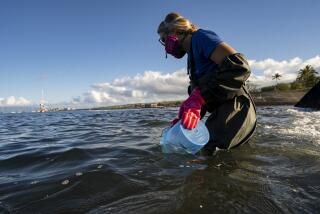Underwater Eruption Offers Rare Look at Major Volcanic Event
- Share via
What is probably the most violent volcanic eruption recorded in the Hawaiian island chain in modern times occurred during the summer, but almost wholly out of sight.
The eruption at the Loihi Seamount, like the 1980 eruption at Mt. St. Helens in Washington state, stripped more than 1,000 feet off the top of a towering mountain. But it could not be seen because the mountain was far below the ocean’s surface.
The undersea Loihi volcano rises more than 10,000 feet off the Pacific floor, 20 miles southeast of the “Big Island” of Hawaii. In about 100,000 years, according to University of Hawaii geophysicist Fred Dunnebier, it may break the ocean surface and may eventually be joined to the island.
But for the time being, after tremendous bursts of seismic activity beginning July 17, followed by major eruptions, its highest point remains more than 3,500 feet down.
A research vessel equipped with a deep-diving submersible craft recently was able to directly explore the heated, turbid water and altered terrain in the vicinity of the eruption.
In a preliminary report, scientists who were aboard said they were able to establish that significant changes had occurred in the summit.
“Former high points, such as Pele’s Vent, formerly rising to 980 meters [about 3,000 feet beneath the surface], have been replaced by pit craters hundreds of meters deep,” the research team reported.
It said the most intense activity probably occurred July 23, and noted, “This is the first recorded formation of a pit crater at a Hawaiian volcano. Pele’s Pit now occupies the former vent area, with a width of 870 feet and a depth of about 1,000 feet.”
“Besides new pit craters, several of the former small and large pits have collapsed and coalesced into a larger summit caldera, which may still be forming,” the scientists said.
Dunnebier said the process is particularly fascinating because it represents a living example of how the “Big Island” has been growing for 1 million years.
The Hawaiian island chain is located over one of the world’s most famous “hot spots,” a rupture in the Earth’s crust out of which have poured countless surges of magma from deep within the planet.
As the area moves tectonically toward the northwest, one island after another has been formed.
The site of volcanic activity remains the same, but on the surface, it appears to be very slowly moving to the southeast. Islands are formed and, when their time above the hot spot ends as the tectonic plate moves, they slowly erode. So to the northwest of the chain, islands disappear. To the southeast they form.
When the recent, intense swarm of earthquakes was recorded at Loihi (2,000 quakes occurred, including 40 between magnitude 4.0 and 5.0), scientists scrambled to organize their expedition to the scene on the research vessel Kaimikai O Kanaloa. Costs were paid by the National Science Foundation. The vessel arrived over the erupting site Aug. 5, as quakes strong enough to be felt aboard were continuing.
Dunnebier said the ship was able to retrieve a selection of volcanic rocks, take temperature samples at various depths and plant microphones in the water to listen to the activity.
But waters near the sea floor were very murky, limiting visibility even with the strongest submersible lights to less than six feet. This impeded extensive exploration of the new terrain and collection of samples.
Still, what has happened at Loihi provides scientists a rare chance to observe, firsthand, major volcanic events.
More to Read
Sign up for Essential California
The most important California stories and recommendations in your inbox every morning.
You may occasionally receive promotional content from the Los Angeles Times.













